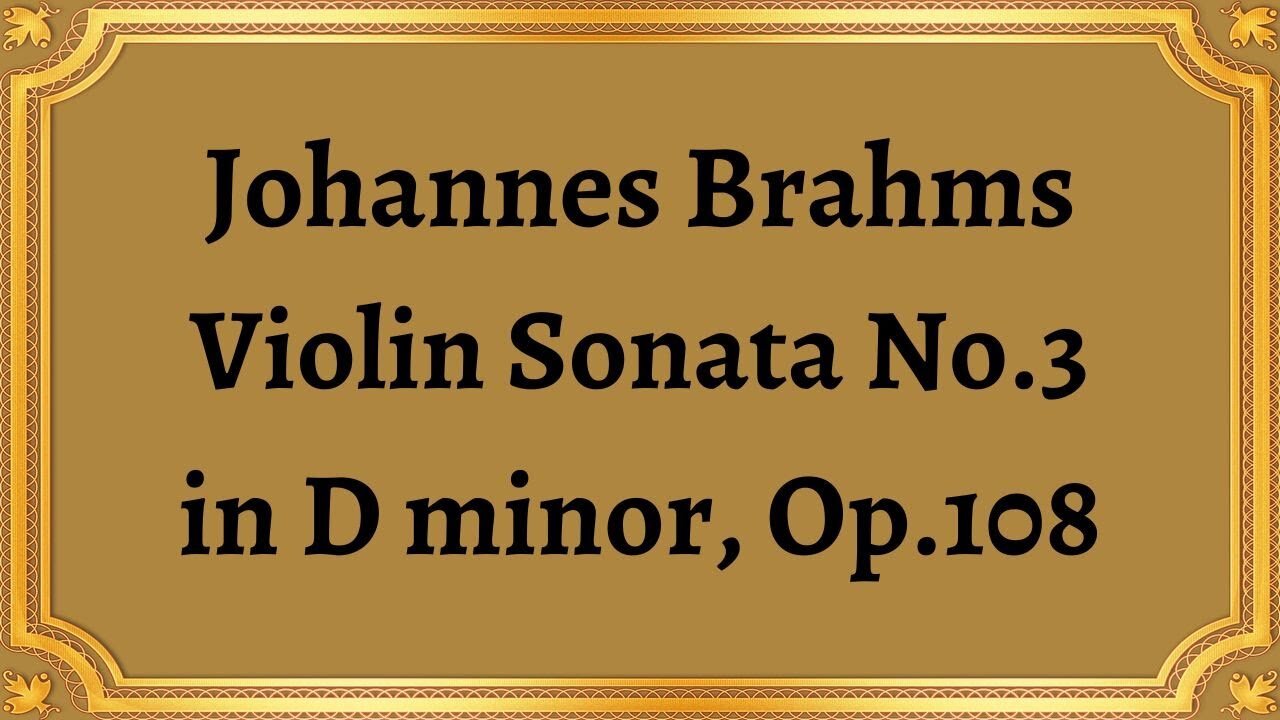Premium Only Content

Johannes Brahms Violin Sonata No.3 in D minor, Op.108
#classical_music #Brahms#sonata
Johannes Brahms's Violin Sonata No. 3 in D minor, Op. 108, is a piece of chamber music that dates back to the Romantic era of classical music. Brahms composed the piece in 1888, and it has since become one of the most beloved works in the violin repertoire, admired for its technical difficulty, emotional expressiveness, and intricate structures.
The sonata is structured in four movements, with each movement intricately connected to the next. The opening movement sets the mood for the entire work, with brooding melodies that create a sense of tension and unease. The second movement is a scherzo, a dance-like movement that provides a musical lightness and rhythm. The third movement is a slow and introspective adagio that showcases Brahms's skill at creating beautiful and moving melodies. The final movement is a high-energy piece that brings the sonata to a powerful and satisfying conclusion.
Brahms's Violin Sonata No. 3 in D minor is more demanding than the previous sonatas in the series, with challenging passages that demand technical mastery from the solo violinist. The sonata's intricate structures require a nuanced understanding of the work, and the performers must work collaboratively to create a cohesive and beautiful performance.
One aspect of the sonata that stands out is its use of counterpoint, a compositional technique in which multiple melodies occur simultaneously, creating a complex and rich sound. In the Violin Sonata No. 3, the use of counterpoint is particularly notable, with the piano and violin often engaging in a musical dialogue that showcases Brahms's exceptional skill at orchestration.
The third movement of the sonata is particularly noteworthy, featuring a long, lyrical melody that is one of the most beautiful in the entire work. Brahms's use of intense harmonies, complex rhythms, and melancholy themes creates a mood that is mournful yet uplifting, exhibiting the depth and range of human emotions that is the hallmark of his work.
In conclusion, the Johannes Brahms Violin Sonata No. 3 in D minor, Op.108, is a masterpiece of classical music that has stood the test of time. Brahms's remarkable skill at combining complex structures, intricate harmonies, and beautiful melodies has produced a work that is both technically demanding and emotionally stirring. The sonata remains a testament to the beauty and power of classical music, and is a beloved work that continues to captivate contemporary audiences.
You have the opportunity to support the channel https://destream.net/live/RadSiarAl/donate
-
 32:30
32:30
Classical music_Music Inspiration
11 days agoArturo Toscanini Grand Canyon Suite
511 -
 1:16:59
1:16:59
T-SPLY
5 hours agoJudge And Protesters Try to Stop ICE Arrest In Court Hallway!
9.02K21 -
 LIVE
LIVE
Grant Cardone
3 hours agoWEALTHCON by GRANT CARDONE DAY 1
1,034 watching -
 LIVE
LIVE
Joker Effect
51 minutes agoFIRST EVER AMATEUR BOXING EVENT STREAMED ON RUMBLE! BOUGHT TO YOU BY WOLFSDEN BOXING!
1,579 watching -
 39:20
39:20
Rethinking the Dollar
1 hour agoTechnocratic World Order: Elon Steps Aside As Palantir Steps In | RTD News Update
8997 -
 52:39
52:39
vivafrei
4 hours agoA Soldier's Journey Home: Sergeant First Class New Home Reveal LIVE!
39.4K6 -
 LIVE
LIVE
Major League Fishing
1 day agoLIVE MLF BFL All-American Championship!
1,733 watching -
![🔴 Live - [ 36 Hr Marathon ]](https://1a-1791.com/video/fww1/7d/s8/1/z/G/-/O/zG-Oy.0kob-small--Live-36-Hr-Marathon-.jpg) LIVE
LIVE
Delnorin Games
4 hours ago🔴 Live - [ 36 Hr Marathon ]
110 watching -
 LIVE
LIVE
Total Horse Channel
17 hours ago2025 Buckeye Reining Spectacular - Saturday
84 watching -
 3:10:55
3:10:55
DrDamon
3 hours ago🟢 LIVE - Degen Gaming with Chat! | Use Code: "DRDAMON" #EpicPartner
5.25K